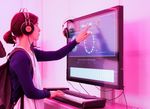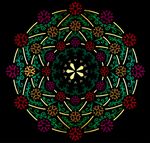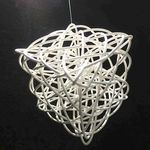La La Lab - The Mathematics of Music - The Bridges Archive
←
→
Page content transcription
If your browser does not render page correctly, please read the page content below
Bridges 2020 Conference Proceedings
La La Lab - The Mathematics of Music
Daniel Ramos and Bianca Violet
IMAGINARY gGmbH, Berlin, Germany.
daniel.ramos@imaginary.org, bianca.violet@imaginary.org
Abstract
We describe a journey through our exhibition La La Lab - the Mathematics of Music, which mixes a laboratory
format with interactive exhibits to present visitors with the historical, conceptual, and artistic connections between
mathematics and music, pushing forward musical creativity, mathematical knowledge and any blending of the two.
What is La La Lab?
Mathematics deeply permeates all aspects of music, from the physics of sound to the crafting of instruments,
from rhythmic patterns to tonal harmony, from classical to electronic music. Mathematics supports music
and our understanding of art the same way as it supports physics and our understanding of the world. Hearing
music through a mathematical lens brings understanding to the music lover, appreciation for details, and a
greater enjoyment of the art; and to professionals the ability to compose music as well as tools to express
their creativity.
We aim to convey this idea to the general public, using the format of an interactive exhibition. This
form of communication and outreach, together with artistic exhibits and new technologies on visualization
and interactive experiences, allows us to pursue the goal of increasing sensibly the mathematical and musical
culture of the visitors, while making the experience entertaining, creative, and playful.
La La Lab - the Mathematics of Music is an exhibition created by IMAGINARY in collaboration with
artists and experts in current research of music and mathematics around the world, combining a laboratory
format with interactive exhibits. All the exhibits are open source and can be downloaded from our platform
imaginary.org to play and explore deeper or to create your own exhibition [5]. It was first displayed at the
Mathematics Informatics Station (MAINS) in Heidelberg, Germany, from May 2019 to March 2020 and
will be exhibited at different venues in the future. MAINS is a project of the Heidelberg Laureate Forum
Foundation (HLFF) [3], which strives to show how stimulating mathematics and computer science can be
and how important their roles are in today’s world.
In the following, we will give a short walk-through and introduction to the exhibits. The name of each
of the 22 exhibits of La La Lab is identified in bold. Most of the exhibits can be played online on the
aforementioned platform [5], where videos and complementary material are also available. More in-depth
explanations can be found in the extensive booklet [4] that we prepared for visitors of La La Lab.
Mathematics of Classical Music Theory
La La Lab is a journey about how music works, how it is built, how it is felt, and what role the underlying
mathematics plays in music. Our trip begins with the first thing we need in order to create music: sound.
With The Spectrum of Sound visitors can explore acoustics and Fourier theory within a two screen exhibit:
On the first touch screen there is a spectrum analyzer attached to a microphone, on the second one a graphical
synthesizer is shown together with a speaker (Figure 1, middle and right). With these tools different sounds
can be merged and decomposed into frequencies. These sounds can be produced synthetically, come from
real musical instruments or from the visitor’s own voice. The voice, by the way, is the oldest and most
451Ramos and Violet
versatile musical instrument, which we can all play. The exhibit Pink Trombone offers a mathematical
model of the human voice that the visitors can control and hear while graphically manipulating an image of
the vocal tract with several fingers via the touch display.
We have now sound and instruments, but we don’t use every sound to make music, we select some pitches
to build a set of notes (a scale) to tune instruments and make music by combining these notes. In the Scale
Lab exhibit (Figure 1, left) several tools are offered to visualize and understand the frequency combinations
that form the basis of harmony in a scale. Visitors can compare different tunings, scales used around the
world, or create their own scale. The Note Compass exhibit offers another perspective: all possible diatonic
scales in the modern Western music are organized by their functional relations, not just by their acoustics.
Figure 1: Scale Lab and Spectrum of Sound (Analyzer and Synthesizer).
We have figured out what scales are, but how can we learn how to use them. The Tonnetz exhibit
offers a graphical representation of the (Western) scale in a grid that orders notes not by their pitch, but
by their affinity, by the intervals and chords that define their musical relationships. It is not only a clever
representation (tracing back to Euler [2]), the geometrical properties of the Tonnetz will give much musical
information, and even the geometric transformations of the Tonnetz grid will create new music pieces with
astonishing harmonies.
Now that we have scales, notes and chords, we need something fundamental to make music alive, a
driving force that moves the notes through time, we need rhythm. Exploring the Beat Box exhibit, the visitors
can play with different applets based on rhythms, and discover their affinity relations based on arithmetic.
Let’s put it all together and make some music based on what we have explored so far on our musical
journey. With the Graph Composer visitors can play and create a piece of music by drawing a graph
(network), where each vertex is a note and each edge defines the transitions from one note to another. This
graph representation is used in research to analyze pieces and to extract features. It is equivalent to a musical
score, just at a more abstract level. And here it allows many visitors to make their first basic composition.
Next, we can go explore new technologies and current research in the music field (AI exhibits), or we
can go enjoy some artistic music accompanied by beautiful visuals (art exhibits and videos), or play with
musical games, or wander around to find another surprise. The exhibition is not linear, the journey can be
made in any order by jumping from one exhibit to another.
Artificial Intelligence and Music
Three exhibits in the collection use the latest current research in music and Artificial Intelligence (AI). With
the AI Jam exhibit, visitors can play a duet together with an AI on a piano and percussion drum pads. The
machine will try to respond to the visitor’s strokes with something that is musically meaningful, according
to the style that the machine has been trained with. How far can AI go in the field of music? Can a machine
reach an expressive level of a human? Can we communicate what we feel expressive to a system? This is a
research topic that can be discovered with Con Espressione!, an exhibit where the visitor takes on the role of
a music conductor and the machine takes the role of a performing pianist. With hand gestures one can give
452La La Lab - The Mathematics of Music
indications of tempo and loudness, and the machine will just obediently change those parameters. However,
the visitor can endow the system with some AI using a slider to control its impact, and the machine will also
adjust other microscopical parameters that make everything more "human". AI is not only applied in music
to composition and performance, but also to sound and acoustics. With the NSynth exhibit, visitors can use
a synthesizer and create new sounds finding an instrument that sounds somewhere between two (or up to
four) examples, which can be chosen from a library, such as a trumpet and a violin, or a car engine, a piano
or even the meow of a cat.
Art Combining Music and Mathematics
In the art section of the exhibition, visitors will find three exhibits based on the mathematical Lissajous figures,
that visualize frequency relations of tones. On the image gallery of Lissajous prints, visitors can look at
whimsical shapes in black and white, this is what harmony looks like in this mathematical artist’s rendition
(Figure 2, middle). There are also similar 3D-printed shapes on display in the exhibit Triad Sculptures
(Figure 2, right), which visitors can touch and observe the different shadows. Similar figures can be generated
by singing into the microphone of the exhibit The Harmonic Series (part 1: with analog laser technology
combined with two microphones, part 2: with a modern 3D display which offers one microphone input and
an adjustable second tone via slider, Figure 2, left). The aforementioned exhibit Scale Lab offers a tool to see
the Lissajous figures of two notes, which can be played on the attached keyboard.
Figure 2: Lissajous exhibits (3D display, pictures, and 3D-print).
Other artistic exhibits include the mesmerizing Whitney Music Box (Figure 3, right), a dance of musical
scales with geometric spirals, that can be controlled by turning a wheel. Or visitors can move through the
space of Pentatonic Scales (Figure 3, left) and create their own impressionistic style music by playing pieces
by classical composers with only five notes. Pentatonic scales are selections of five out of the twelve notes
in our tonal system, with the restriction that no two neighbouring notes are selected. Under these conditions,
there are exactly 36 pentatonic scales visitors can explore with this exhibit. Another good place to admire
examples of maths in music is the Show Me Music station. Visitors will find short and quick visualizations
of musical and acoustic effects that can be experienced with a couple of control parameters. During the visit
of the exhibition, visitors may also sit down on The Musical Bench, which makes twinkling music when
people hold the armrests while touching, kissing, or holding hands (Figure 3, middle).
Miscellaneous Exhibits
The exhibition has other modules that complement and round up the collection. The Hands-on Table invites
visitors to start exploring and tinkering. They may also spend some time watching artistic and insightful short
movies in the Film Station (quite a few of the selected films had originally been screened at The Bridges Short
Film Festival). The exhibition features a so-called Silent-area, where visitors can sit in the library to rest and
deepen their understanding by browsing some articles and books with background information. They can be
inspired by the Mind and Music Jukebox listening to the music that the greatest minds of mathematics and
453Ramos and Violet
Figure 3: Pentatonic Scales, Musical Bench, and Whitney Music Box.
computer science like the most. We asked mathematicians and researchers from the “Women of Mathematics
throughout Europe” exhibition project [7], and recipients of the most prestigious awards in mathematics and
computer science [1], to fill the jukebox with their favourite music pieces. Visitors can also get inspired by
pure mathematics by hearing numeric patterns in the exhibit The Sound of Sequences. Numerical sequences
taken from the Online Encyclopedia of Integer Sequences (OEIS) [6] are mapped onto sounds that can be
heard, revealing features of the sequence but also creating “music” pieces interesting in their own right.
Summary and Conclusions
The exhibition La La Lab - The mathematics of music covers all major topics in music theory, contains
genuine art works, current research, games and playful modules, all of them showing a connection between
mathematics and music. Furthermore, the exhibition addresses a connection between two fields of active
research a connection that might not be easily apparent from every day life experiences. It used new formats
and visualizations tools that had not been used in the past to help easily convey the complexity of the presented
topics. This opens very interesting opportunities for its use as a non-formal learning experience for visitors
without musical training, and as a very enriching complement for those with it. IMAGINARY is open to new
collaborations and to establish relationships to bring La La Lab to new locations. Everyone is also invited to
download exhibits, to explore them at home, and to recreate a version of the exhibition. We also welcome
new ideas and new exhibits, which can be added to La La Lab in the future.
Acknowledgements: This exhibition was created by IMAGINARY in collaboration with international partners,
presented by the Heidelberg Laureate Forum Foundation, made possible by the Klaus Tschira Stiftung, and
supported by the Technical University of Munich. We thank all authors and contributors, advisors, artists,
software developers, designers, carpenters, exhibition guides, IMAGINARY team members, and everyone
from HLFF—all the people who made La La Lab possible [4].
References
[1] Badge, Peter. Masters of Abstraction. Edition 2018. Heidelberg Laureate Forum Foundation.
[2] Euler, Leonhard. Tentamen novae theoriae musicae ex certissismis harmoniae principiis dilucide
expositae, 1739.
[3] Heidelberg Laureate Forum Foundation. https://www.hlf-foundation.org/.
[4] La La Lab. Exhibition booklet. 2019. https://imaginary.org/sites/default/files/lala-booklet.pdf.
[5] La La Lab. Exhibition website. http://lalalab.imaginary.org/.
[6] Online Encyclopedia of Integer Sequences (OEIS). https://oeis.org/.
[7] Women of Mathematics throughout Europe. https://womeninmath.net/.
454You can also read

























































